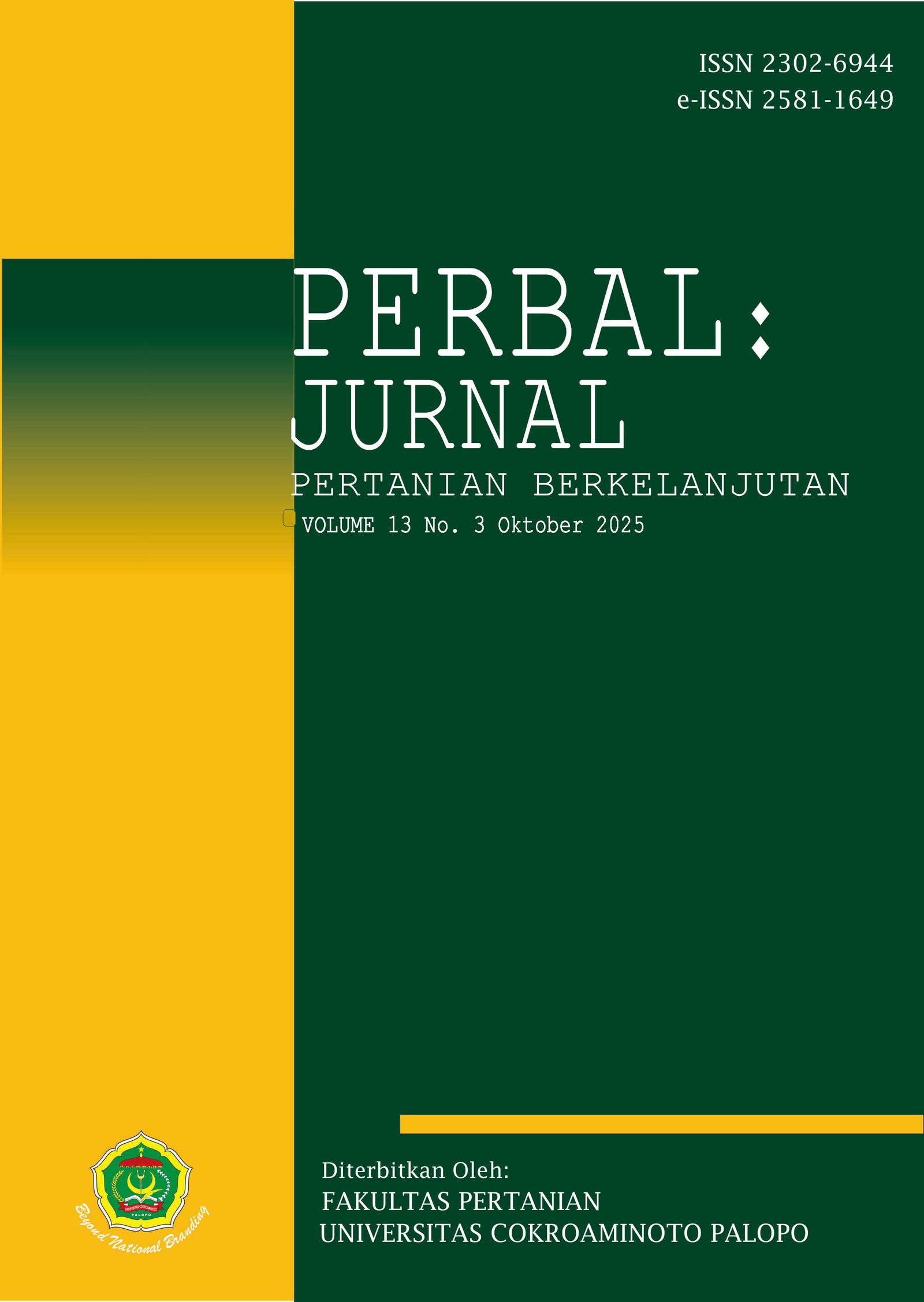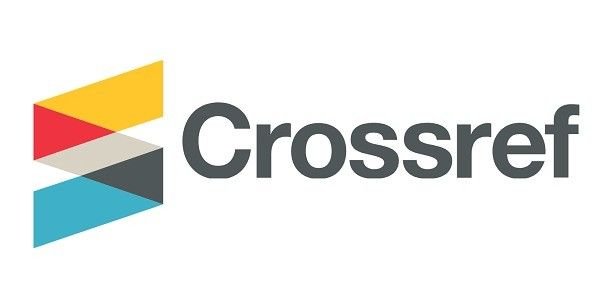Analisis Kebutuhan Air dan Koefisien Tanaman Bawang Merah (Allium cepa L.) Menggunakan Aplikasi CropWat 8.0
Analysis of Water Requirements and Coefficients of Shallot Plants (Allium cepa L.) Using the CropWat 8.0 Application
DOI:
https://doi.org/10.30605/perbal.v13i3.6773Keywords:
Bawang merah, CropWat 8.0, kebutuhan air, koefisien tanamanAbstract
Penelitian ini bertujuan untuk mengetahui kebutuhan air dan koefisien tanaman bawang merah menggunakan aplikasi CropWat 8.0. Penelitian ini dilaksanakan di Kelurahan Takkalala, Kecamatan Wara Selatan, Kota Palopo, yang dimulai pada tanggal 13 Desember 2024 sampai tanggal 8 Maret 2025. Metode percobaan yang digunakan untuk menghitung Kebutuhan air dan koefisien tanaman menggunakan CropWat 8.0 dengan metode Penman-Monteith. Berdasarkan hasil analisis kebutuhan air dan koefisien tanaman bawang merah menggunakan aplikasi CropWat 8.0, dapat disimpulkan bahwa kebutuhan air tanaman bawang merah mengalami fluktuasi sepanjang fase pertumbuhan. Kebutuhan air tertinggi terjadi pada fase initial (fase awal pertumbuhan) dengan nilai 67,20 mm/day dan fase mid-season (fase pembentukan umbi) dengan nilai 63,73 mm/day, kemudian mengalami penurunan pada fase crop development dengan nilai 58,39 mm/day dan fase late season (fase akhir pertumbuhan) dengan nilai 58,32 mm/day. Demikian juga, dengan nilai koefisien tanaman (Kc) bawang merah mengalami fluktuasi sepanjang fase pertumbuhan. Nilai koefisien tanaman (Kc) bawang merah tertinggi terjadi pada fase initial dengan nilai 17,28, selanjutnya fase mid-season dengan nilai 16,38, kemudian fase crop development dengan nilai 15,01 dan fase late season dengan nilai 14,99. Pola ini menunjukkan bahwa ketersediaan air yang optimal sangat krusial pada fase-fase awal (initial) dan puncak pertumbuhan tanaman (mid-season). Dengan demikian, manajemen irigasi yang tepat waktu dan efisien pada fase initial dan mid-season sangat penting untuk mendukung pertumbuhan optimal dan hasil produksi maksimal. Pengaturan kebutuhan air yang disesuaikan dengan fase pertumbuhan akan meningkatkan efisiensi penggunaan air dan mengurangi resiko penurunan produktivitas akibat kekurangan irigasi.
This study aimed to determine the water requirements and crop coefficient (Kc) of shallots using the CropWat 8.0 application. The research was conducted in Takkalala Village, Wara Selatan Subdistrict, Palopo City, from December 13, 2024, to March 8, 2025. Water requirements and crop coefficients were calculated using the Penman-Monteith method with CropWat 8.0. The results showed that shallot water requirements fluctuated across growth stages, with the highest values recorded during the initial stage (67,20 mm/day) and mid-season stage (63,73 mm/day), followed by a decline in the crop development stage (58,39 mm/day) and late-season stage (58,32 mm/day). Similarly, the crop coefficient (Kc) values varied throughout the growth cycle, peaking in the initial stage (1.728), decreasing in the mid-season (16,38), crop development (15,01), and late-season (14,99) stages. These findings highlight the critical importance of ensuring optimal water availability during the initial and mid-season stages to support maximum growth and yield. Properly managing irrigation according to the crop growth phases enhances water-use efficiency and reduces the risk of yield losses due to under-irrigation.
Downloads
References
Allen, R.G., Pereira, L.S., Raes, D., & Smith, M. (2018). Crop Evapotranspiration: Guidelines for Computing Crop Water Requirements. Irrigation and Drainage Paper 56, Food and Agriculture Organization of the United Nations, Rome. 300 hlm.
Allen, R.G., Pereira, L.S., Raes, D., & Smith, M. (1998). Crop Evapotranspiration: Guidelines for Computing Crop Water Requirements (FAO Irrigation and Drainage Paper No. 56). Rome: FAO.
Aprilia, L., Sirait, S., & Fachruddin. (2020). Analisis neraca air dan kebutuhan air tanaman jagung (Zea mays L.) berdasarkan fase pertumbuhan di Kota Tarakan. Jurnal Rona Teknik Pertanian, 13(1). DOI: https://doi.org/10.17969/rtp.v13i1.15856
Aydın, Y. (2022). Quantification of water requirement of some major crops under semi-arid climate in Turkey. Peer J, 10. https://doi.org/10.7717/peerj.13696. DOI: https://doi.org/10.7717/peerj.13696
Badan Penelitian dan Pengembangan Pertanian. (2019). Budidaya Bawang Merah. Badan Penelitian dan Pengembagan. Kementerian Indonesia.
BPS (Badan Pusat Statistik). 2024. Statistik Bawang Merah Indonesia Tahun 2021-2023.
Debebe, A., Nurga, Y., Tesfaye, H., Bekele, S., & Meskelu, E. (2024). Response of onion to deficit irrigation levels at different growth stages on yield and water productivity. International Journal of Advanced Multidisciplinary Research and Studies, 4(6), 183-187. DOI: https://doi.org/10.62225/2583049X.2024.4.6.3413
FAO. (2012). Crop yield rensponse to water. FAO Irrigation and Drainage Paper No. 66. Food and Agriculture Organization of the United Nations. Rome. Italy.
FAO. (2020). Agriculture Statistics Database. https://www.fao.org.
Minhas, P.S., Bal, S.K., Suresh Kumar, P., Singh, Y., Wakchaure, G.C., Ghadge, S.V., Nangare, D.D., & Taware, P.B. (2023). Turning Basaltic Terrain Into Model Research Farm: Chronicle Description. NIASM Technical Bulletin 8, ICAR-NIASM, Baramati, Pune Maharashtra, India, pp. 64.
Mousa, A. M., El-Sherbeny, T.M.S., & El-Sayed, R. (2022). Use of mycorrhizal fungi and phosphorus fertilization to improve the yield of onion (Allium cepa L.) plant. Saudi Journal of Biological Sciences, 29, 331-338. https://doi.org/10.1016/j.sjbs.2021.08.094. DOI: https://doi.org/10.1016/j.sjbs.2021.08.094
Nazeer, M. (2019). Simulation of maize crop under irrigated and rainfed conditions with CropWat model. ARPN Journal of Agricultural and Biological Science, 4(2), 68-73.
Rizqiyah, F. (2019). Dampak Pengaruh Perubahan Iklim Global terhadap Produksi Kedelai (Glicine Max L. Merril) Di Kabupaten Malang. Fakultas Teknologi Pertanian Universitas Brawijaya. Malang. 7 hlm.
Smith, J. (2020). Smart irrigation scheduling using eta and sensor data. Journal of Precision Agriculture.
Smith, M. (1992). CropWat: A Computer Program for Irrigation Planning and Management (FAO Irrigation and Drainage Paper N0. 46), Rome: FAO.
Soto, V.C., Gabri, C.G., Antonio, A.I., & Galmarini, C.R. (2024). Foliar application of boron, calcium, and indole-3-butyric acid on onion plants to improve seed production. Italian Journal of Agronomy, 19, 100008. https://doi.org/10.1016/j.ijagro.2024.100008. DOI: https://doi.org/10.1016/j.ijagro.2024.100008
Sudaryono, T.Y. (2019). Pengaruh modifikasi media tumbuh dan penggunaan zat pengatur tumbuh untuk meningkatkan daya tumbuh dan pertumbuhan benih bawang merah sejati (TTS). Jurnal Biotika, 6(19), 2410-9290.
Susanto, R., Handoko, D.D., & Yuliasari, D. (2022). Analisis kebutuhan air tanaman hortikultura berdasarkan fase pertumbuhan. Jurnal Irigasi dan Drainase Indonesia, 10(2), 101-108.
Suwandi., Sopha, G.A., & Hermanto, C., (2019). Petunjuk Teknis (JUKLIS) Proliga Bawang Merah 40 T/Ha Asal TSS (True Shalat Seed). Balai Penelitian Tanaman. Kementrian Pertanian.
Tolossa, T. (2021). Variation of crop coefficient (kc) of onion across phenological stages. Dalam Sumarianti, A., Rahmawati, D., & Sari, P. 2022. Jurnal Agrovigor, 15(2), 12-19.
Triharyanto, E., Wijayanti, D.P., & Setyaningrum, D. (2022). Morphology, structureand potential of bulbils yield as a planting material of onion in tropical region. Univers. J. Agric, Res, 10(3), 204-212. DOI: https://doi.org/10.13189/ujar.2022.100303
Zaman, K., Tariq, M., Arshad Khan, M., Mansoor, M., Ali, R., Jamil, M., Yaqoo, M., & Waheed, M. (2019). Maximizing onion seed production through foliar application of zinc and boron. Pak. J. Sci. Ind. B: Biol. Sci. 62(1), 1-7. DOI: https://doi.org/10.52763/PJSIR.BIOL.SCI.62.1.2019.1.7
Downloads
Published
Issue
Section
License
Copyright (c) 2025 Nurfadillah Nurfadillah To Kau, Yumna Yumna, Akmal Akmal

This work is licensed under a Creative Commons Attribution 4.0 International License.
In submitting the manuscript to the journal, the authors certify that:
- They are authorized by their co-authors to enter into these arrangements.
- The work described has not been formally published before, except in the form of an abstract or as part of a published lecture, review, thesis, or overlay journal.
- That it is not under consideration for publication elsewhere,
- That its publication has been approved by all the author(s) and by the responsible authorities – tacitly or explicitly – of the institutes where the work has been carried out.
- They secure the right to reproduce any material that has already been published or copyrighted elsewhere.
- They agree to the following license and copyright agreement.
License and Copyright Agreement
Authors who publish with Onoma Journal: Education, Languages??, and Literature agree to the following terms:
- Authors retain copyright and grant the journal right of first publication with the work simultaneously licensed under Creative Commons Attribution License (CC BY 4.0) that allows others to share the work with an acknowledgment of the work's authorship and initial publication in this journal.
- Authors are able to enter into separate, additional contractual arrangements for the non-exclusive distribution of the journal's published version of the work (e.g., post it to an institutional repository or publish it in a book), with an acknowledgment of its initial publication in this journal.
- Authors are permitted and encouraged to post their work online (e.g., in institutional repositories or on their website) prior to and during the submission process, as it can lead to productive exchanges, as well as earlier and greater citation of published work.














